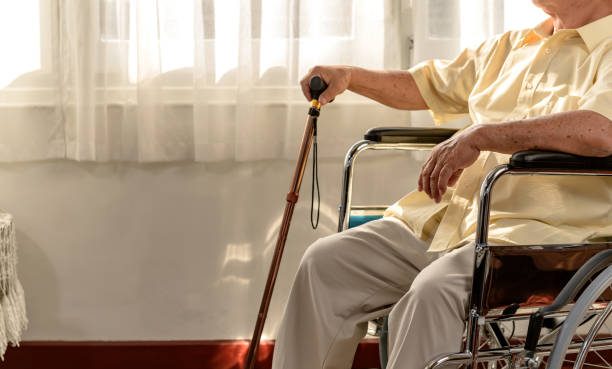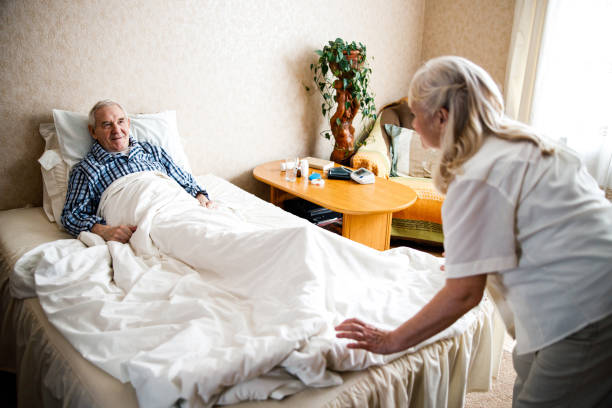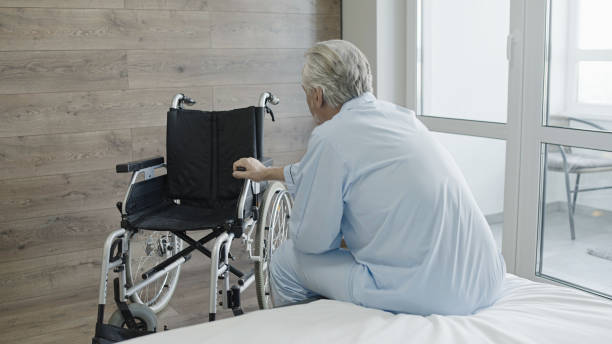Introduction

It is no secret that mobility issues are a common symptom of Parkinson's Disease (PD). One of the most significant challenges people living with PD may face is difficulty moving from the bed. As such, exploring medical solutions for improving bed mobility is important.
This blog post aims to help individuals with Parkinson's disease to manage their bed mobility challenges by discussing tips, techniques, and medical solutions. It also highlights the potential benefits of each solution and guides how to choose the best model that suits individual needs. Our goal is to enable people with Parkinson's disease to be more self-sufficient in managing their care.
What is Parkinson's Disease?
Parkinson's Disease (PD) is a neurological disorder that affects movement and can cause tremors or shaking, slow movement, stiffness of the limbs, and difficulty with balance. PD is caused by a loss of dopamine-producing brain cells, which results in changes to the patient's motor control. As the disease progresses, it can lead to complications with walking and other basic physical functions.
Assessing current medical solutions for bed mobility issues with Parkinson's

There are several solutions to assess for bed mobility issues with Parkinson's Disease, each with benefits and drawbacks. Here are five ways to explore the current medical solutions available:
1. Speak with a healthcare professional
The first step in assessing medical solutions for bed mobility issues with Parkinson's is to speak with a healthcare professional with experience dealing with this particular condition. A doctor or specialist can advise on the best course of action and provide advice on the most suitable treatments available.
This consultation should include an examination and a discussion of any lifestyle changes necessary to improve the quality of life. Additionally, they may recommend physical therapy sessions or other treatments that can help improve mobility and reduce pain. Lastly, they will be able to provide information on any medications or supplements that could help manage the symptoms of Parkinson's disease.
2. Research available solutions
In addition to speaking with a healthcare professional, it's also important to research the various medical solutions available for bed mobility issues with Parkinson's disease. Patients should read about what other individuals have tried and the results they achieved to make an informed decision regarding their treatment.
Additionally, they should look into the latest medical innovations that may provide better results than traditional methods. This can include looking into new technologies, such as a system of friction-reducing sheets and sleepwear, robotic devices or exoskeletons, to assist with mobility.
3. Consider home adjustments
Another potential solution for bed mobility issues with Parkinson's disease is to make adjustments at home. This may include installing grab bars or other aids that can assist with getting in and out of bed or reaching items on the nightstand. Additionally, furniture should be arranged to maximize safety and reduce falls. Installing adjustable beds that support individuals with difficulty sitting in bed can also be beneficial.
4. Utilize adaptive equipment
Utilizing adaptive equipment can also be a great solution for improving bed mobility with Parkinson's disease. This may include using a mechanical lift that allows individuals to move from the bed to a wheelchair or other mobility device without transferring. Additionally, therapeutic mattresses and special cushions can provide additional support. Lastly, various devices are available to help with sleep positionings, such as a system of friction-reducing sheets and sleepwear designed to promote mobility and freedom of movement, bed wedges or body pillows.
5. Use assistive technology
Assistive technology can also be used to improve bed mobility for those living with Parkinson's disease. This may include using voice-activated devices to control lighting, adjust thermostats, or operate other electronic devices in the room. Additionally, automated bed systems can help position and transfer from the bed to a chair. Lastly, virtual reality solutions can be used to improve balance and coordination.
By exploring the various medical solutions available for bed mobility issues associated with Parkinson's disease, individuals can find the best approach for improving their quality of life. By speaking with a healthcare professional and researching available options, patients can make an informed decision regarding how to best manage their condition.
Home adjustments, adaptive equipment, and assistive technology can also help improve bed mobility and reduce fall risks. With these solutions in mind, those with Parkinson's disease can have increased safety and independence while getting the rest they need.
Innovative Features to Consider When Choosing a Bed for Bed Mobility Issues with Parkinson's Disease

When exploring medical solutions for bed mobility issues with Parkinson's disease, there are several innovative features to consider. An adjustable bed base is essential for those with limited mobility and can be adapted for different positions to alleviate pain, improve circulation, and increase comfort. Additionally, an adjustable mattress height feature can help prevent falls and make transferring in and out of bed easier.
An ergonomic design is also beneficial for those with Parkinson's Disease, as it can help provide support and comfort while sleeping or sitting upright. Specialized mattresses designed to reduce pressure points, such as memory foam or gel-infused mattress cores, can also help support those with bed mobility issues. Finally, adjustable massage settings can help to reduce pain and improve relaxation.
Choosing the right bed for an individual or their loved one is essential in ensuring safety, comfort, and quality of life. With these features in mind, those with Parkinson's disease can find the perfect bed. With the right bed and mattress, those living with Parkinson's disease can rest easy knowing that their bed is designed to meet their individual needs.
This article is not intended as medical advice but for informational purposes only. Please consult your physician before making any decisions regarding treatments or products related to medical conditions. Additionally, it is important to consider an individual's specific needs before selecting a bed or mattress. With the help of a trained healthcare professional, those with Parkinson's disease can find the perfect bed to meet their needs.
Tips for Ensuring Safety While Using a Bed for Bed Mobility Issues with Parkinson's Disease
Having mobility issues can be difficult, especially if you're living with Parkinson's disease. When getting in and out of bed, choosing the right medical solutions is important for safety and comfort. Here are some tips for exploring medical solutions for bed mobility issues with Parkinson's disease:
1 Consider your current physical ability
Before choosing a medical solution for bed mobility issues, assessing your current physical ability and limitations is important. This will help you determine which bed and mobility aid type is most suitable for you.
2. Talk to your doctor
Your healthcare provider can provide valuable insights into the best medical solutions for bed mobility issues with Parkinson's. They can recommend products to help you get in and out of bed, as well as other medical aids that may be beneficial.
3. Try different beds
A wide range of beds are available for people living with Parkinson's disease, so it's worth taking the time to try out different beds to see which one works best for your needs. Consider the size of the bed, as well as features such as adjustable heights and reclining positions.
4. Look into mobility aids
A mobility aid could be beneficial if you're struggling with getting in and out of bed alone. There are various types of mobility aids, such as friction-reducing, mobility-enhancing garment and sheet sets, bed pulls/ rope ladders, lifts, overhead trapeze bars, and standing frames, that you can consider.
These tips can help you explore medical solutions for bed mobility issues with Parkinson's disease so that you can get the support you need to stay safe and comfortable. The right bed and mobility aid can help with independence and a good quality of life.
Effects of Exercise on Mobility in People With Parkinson's Disease
Here are some Effects of Exercise on Mobility in People With Parkinson's Disease:
-
Regular exercise has been shown to improve balance, gait, posture, and overall mobility in people with Parkinson's Disease. Exercise can help reduce the risk of falls common with this condition.
-
Aerobic activity such as walking or running on a treadmill can increase endurance and muscle strength, which helps improve mobility.
-
Resistance training can help increase muscle strength, balance, and coordination which are all essential for improved mobility.
-
Stretching exercises such as yoga and tai chi can improve flexibility and range of motion, which is important for better movement.
-
Aquatic exercise is particularly beneficial when it comes to improving mobility in people with Parkinson's Disease. The water supports the body and reduces joint stress, allowing for better movement and balance.
Exploring Medical Solutions for Bed Mobility Issues with Parkinson's Disease can provide solutions for those having difficulty getting in and out of bed due to their condition. In addition to exploring medical solutions, regular exercise can be extremely beneficial for improving mobility in people with Parkinson's Disease.
Regular physical activity and exercise can help improve balance, gait, posture, muscle strength, flexibility, and range of motion, all important components of improved mobility. You can improve your mobility and quality of life with the right combination of medical solutions and exercise tailored specifically to your needs. Talk to your doctor or physical therapist about the best course of action for improving your mobility with Parkinson's Disease.
FAQ's
How do you maintain mobility with Parkinson's disease?
Maintaining mobility with Parkinson's Disease can be accomplished through medical solutions and regular exercise tailored specifically to the individual. Exploring Medical Solutions for Bed Mobility Issues with Parkinson's Disease can provide solutions such as beds and mobility aids to help get in and out of bed.
Regular physical activity, including aerobic exercise, resistance training, stretching, and aquatic exercise, can help improve balance, gait, posture, muscle strength, flexibility, and range of motion, all important components of improved mobility.
What is a mobility aid for patients with Parkinsonism?
A mobility aid for Parkinson's is any equipment or device that helps improve a patient's ability to move around. Different mobility aids are accessible, such as friction-reducing garment and sheet sets, lifts, overhead trapeze bars, and standing frames. Talk to your doctor or physical therapist about which type of mobility aid best suits your needs.
Can exercise improve mobility in Parkinson's Disease?
Yes, regular exercise has been shown to improve balance, gait, posture, and overall mobility in people with Parkinson's Disease. Exercise can help reduce the risk of falls common with this condition. Aerobic activity such as walking or running on a treadmill can increase endurance and muscle strength, which helps improve mobility.
What is the best mobility aid for Parkinson's?
The best mobility aid for Parkinson's Disease will depend on the individual and their specific needs. Generally, friction-reducing sheet and garment sets can help get in and out of bed, bed rails to enhance safety, standing frames to help with transfers, and lift chairs or lifts to get into higher positions.
What are the solutions for Parkinson's disease?
There are several solutions for Parkinson's Disease, ranging from medical treatments to lifestyle modifications. Exploring Medical Solutions for Bed Mobility Issues with Parkinson's Disease can provide solutions such as beds and mobility aids to help get in and out of bed.
Regular physical activity, including aerobic exercise, strength training, stretching, and aquatic exercise, can improve balance, gait, posture, muscle strength, and range of motion. Additionally, some medications, such as levodopa, can help to reduce symptoms.
How can I improve my movement with Parkinson's?
Improving movement with Parkinson's Disease can be done through medical solutions and regular exercise tailored specifically to the individual. Exploring Medical Solutions for Bed Mobility Issues with Parkinson's Disease can provide solutions such as beds and mobility aids to help get in and out of bed.
Conclusion
I hope this article has given you a better understanding of what medical solutions and lifestyle changes can improve mobility with Parkinson's Disease. Talk to your doctor or physical therapist about the best course of action for improving your mobility with Parkinson's Disease. You can improve your mobility and quality of life with the right combination of medical solutions and exercise tailored specifically to the individual.

